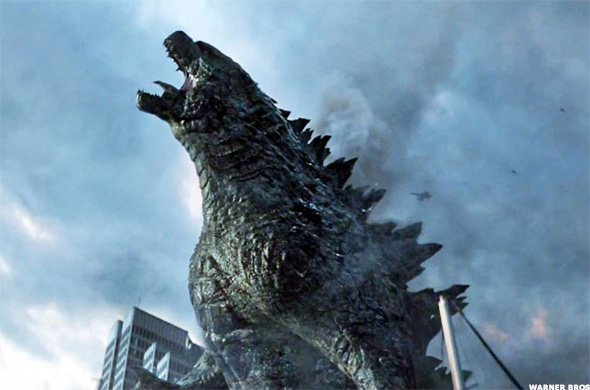PORTLAND, Ore. (TheStreet) -- It's good to see Godzilla back in giant, radioactive fire-breathing form, but the giant movie monster will never be bigger in the U.S. than it was 60 years ago.
With all respect to lead actor Bryan Cranston, director Gareth Edwards and the folks at Legendary Pictures, this year's Godzilla incarnation could make $1 billlion at the box office and never have the impact of 1956's Godzilla: King Of The Monsters. I said it five years ago in The Huffington Post and I'll say it here: It is the single most important foreign film in U.S. history.

Even though it wasn't even the best version of that film available, it made foreign film palatable to what was a fairly xenophobic American moviegoing audience. It made everything from The Seven Samurai to last year's Instructions Not Included fair game for U.S. cinema screens. But it didn't do so easily. The U.S. movie market in 1956 wasn't exactly a cardboard city that Godzilla could wade into and trample. There weren't a whole lot of foreign films screened here and those that were didn't come with subtitles. Toho had tapped directly into Japan's deepest post-World War II fears when Gojira was released in 1954. Less than a decade after having atomic bombs dropped on Hiroshima and Nagasaki by the United States at the end of World War II, Japan was dealing with the literal fallout of U.S. atomic testing in the Pacific. The Castle Bravo test of a 15-megaton hydrogen bomb on the Bikini Atoll in 1954 scorched the crew of the nearby Japanese fishing boat Lucky Dragon 5 with radiation and tainted the food supply with radioactive fish. Gojira didn't flinch from public reaction to that incident and showed children being treated for radiation burns and families incinerated: A fantastic recap video at Slate goes into greater detail, but basically the dark nature of Gojira wasn't going to fly with a U.S. audience that liked its movie monsters more like 1933's King Kong -- which was rereleased in 1952 and 1956 -- and 1953's Beast From 1,000 Fathoms.
Gojira was recut to add scenes with American actor Raymond Burr and subtract the more affecting footage to make Godzilla: King Of The Monsters for release in the U.S. Critics absolutely hated it, with The New York Times saying, As though there are not enough monsters coming from Hollywood, an organization that calls itself Jewell Enterprises has had to import one from Japan.
They were drowned out by the audience's roars. Jewell Enterprises $100,000 lease of the film from Toho Pictures turned into a $2 million run at the box office. The run created a legend in Godzilla, but also built the business model that drives foreign films imports to this day. In 2014 dollars, Jewell's initial investment was $872,000 against a gross of $17.4 million, proving that cult films could make huge profits even if they didn't end up being blockbusters.

Godzilla conquered America one Saturday afternoon TV matinee at a time, but bankrolled the Japanese film industry. Toho saw Godzilla's success and licensed their lead monster and monster buddies for comic books, cartoons, video games and apparel. Flush with cash, Toho used the money to not only fund the films of Akira Kurosawa -- whose Seven Samurai released the same year King Of The Monsters came to the U.S. -- but also all of Hayao Miyazaki's anime work (including Spirited Away and Howl's Moving Castle) and the Pokemon movies. Miyazaki's films have made more than $44 million here, in figures adjusted for inflation. The Pokemon series made $149 million in the U.S., which translates to $226 million in today's dollars. Since 1980, foreign-language films have made more than $1.7 billion in the U.S., led by the $128 million made by Ang Lee's Crouching Tiger, Hidden Dragon in 2000. Granted, that's still less money than the $136 million that director Roland Emmerich's roundly panned, giant iguana Godzilla made here in 1998, but the fact that it was anywhere in the same ballpark as a summer blockbuster speaks volumes about how far the U.S. moviegoer has come since. It also speaks to the box-office power of Godzilla. When Toho offered the U.S. Godzilla 2000 as an apology two years after Emmerich's Taco Bell Godzilla travesty, that poorly dubbed, rubber-suited battle royale took in more than $10 million. That's about $4 million more than U.S. audiences paid that year to see Alec Baldwin, William H. Macy, Sarah Jessica Parker and Phillip Seymour Hoffmann in the ensemble comedy State and Main and $2 million more than they paid for Disney's 2000 re-release of Fantasia. It's also just about what audiences paid to see an imported cut of Jackie Chan's Legend of the Drunken Master. This year's Godzilla will put the giant reptile back into blockbuster territory, but the beast's radioactive breath has spent the last 60 years blazing a far more impressive trail. -- Written by Jason Notte in Portland, Ore. >To contact the writer of this article, click here: Jason Notte. >To follow the writer on Twitter, go to http://twitter.com/notteham. >To submit a news tip, send an email to: tips@thestreet.com. >>Read More: NFL Draft Can't Fix A Broken League NFL Sponsorship Is A Thankless Trap What The NFL Owes Taxpaying Fans
Stock quotes in this article: TWX, SNE Jason Notte is a reporter for TheStreet. His writing has appeared in The New York Times, The Huffington Post, Esquire.com, Time Out New York, the Boston Herald, the Boston Phoenix, the Metro newspaper and the Colorado Springs Independent. He previously served as the political and global affairs editor for Metro U.S., layout editor for Boston Now, assistant news editor for the Herald News of West Paterson, N.J., editor of Go Out! Magazine in Hoboken, N.J., and copy editor and lifestyle editor at the Jersey Journal in Jersey City, N.J.
No comments:
Post a Comment